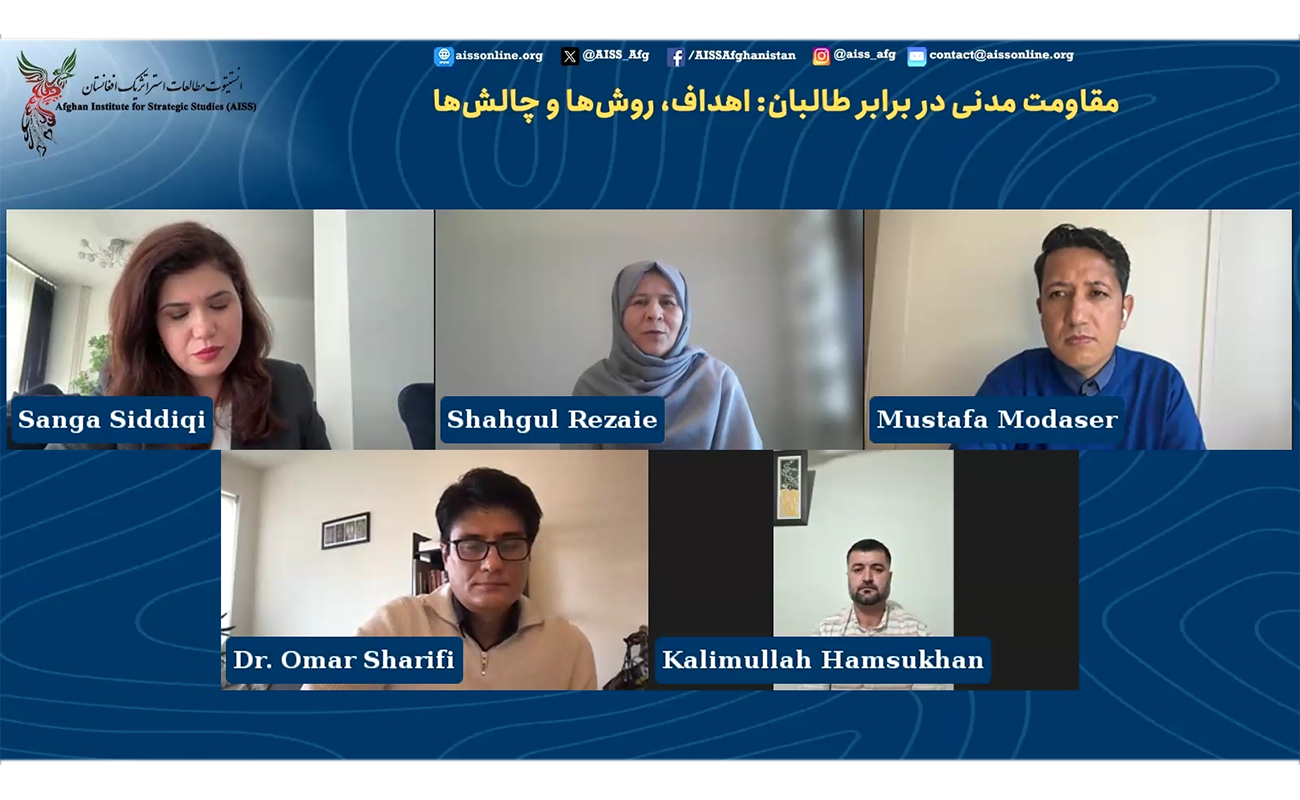Webinar: Civil Resistance Against the Taliban – Goals, Methods, and Challenges
As part of its ongoing initiatives, the Afghan Institute for Strategic Studies (AISS) hosted a webinar titled “Civil Resistance Against the Taliban: Goals, Methods, and Challenges” on April 27, 2025. The panel featured Dr. Omar Sharifi, anthropologist and professor at the American University of Afghanistan; Shahgul Rezai, former member of Afghanistan’s Parliament; Sanga Siddiqi, legal expert and political activist; and Kalimullah Hamsukhan, political activist and member of the Federalists Assembly of Afghanistan. Mustafa Modaser, an international relations expert, started the webinar by raising the need to revisit the idea of civil resistance against the Taliban and to reconsider its historical and regional conditions.
Dr. Omar Sharifi began by recalling the early foundations of civil resistance in the thought of Henry David Thoreau and the movements of Gandhi. He pointed to the mass rush toward Kabul airport during the collapse as an unmistakable rejection of Taliban rule. Although no organized resistance structure existed, Sharifi argued, such collective actions carried a powerful message: a refusal to recognize Taliban rule as legitimate. He stressed that Afghanistan’s social fabric holds a latent capacity for civil resistance, one that—though fragmented and hidden—persists against the Taliban’s imposed order.
Sanga Siddiqi approached the subject from a legal perspective. She defined civil disobedience as the citizens’ refusal to comply with laws and commands that violate principles of justice. Drawing on regional historical examples such as Abdul Ghaffar Khan’s nonviolent movement, she pointed out that Afghanistan, too, has a legacy of civil resistance, although largely concealed and lacking mass organization. Siddiqi noted that one of the main obstacles to the growth of civil resistance in Afghanistan is the absence of a clear legal framework and the unpredictability of legal structures, both of which undermine activists’ psychological security.
Kalimullah Hamsukhan continued the discussion by reflecting on the philosophy of resistance itself. He described resistance as emerging from a sense of awareness, humiliation, and social denial. According to him, Afghan society is saturated with institutionalized violence—violence woven into speech, education, and even religious teachings. While civil resistance in Afghanistan is undoubtedly difficult, Hamsokhan argued, it is not impossible. Referencing previous failed movements such as the Enlightenment Movement, Tabassum Movement, and Uprising for Change, he observed that the lack of a robust middle class and widespread political consciousness has prevented civil movements from achieving sustainable momentum.
Shahgul Rezaie emphasized that Afghanistan has witnessed sporadic protests rather than sustained and strategic civil resistance. Pointing to the brutal suppression of women’s protests under Taliban rule, she acknowledged the bravery of these isolated acts but noted that without effective leadership, intellectual cohesion, shared visions of struggle, and the mending of historical social rifts, such movements have been unable to evolve into forces capable of transformative change. Rezaie insisted that there is still space to build civil resistance—especially if political elites, civil society, and the diaspora emphasize common ground and develop long-term, organized programs for change.
In the interactive segment, the speakers responded to questions regarding the role of international organizations, the potential for applying legal pressure on the Taliban, and the possible impact of the Afghan diaspora. Siddiqi noted that while international advocacy efforts might not produce immediate results, they play a crucial role in maintaining the legal legitimacy of the resistance and exerting long-term pressure on the Taliban. Hamsokhan, with a more critical tone, warned that relying on external change was a grave error; the only viable path lies in investing in internal awareness and societal dynamism.
In closing, all speakers agreed that civil resistance against the Taliban is necessary, though the paths and prospects may differ. There was a shared understanding that leaving the present condition untouched would only pull Afghanistan deeper into paralysis.

